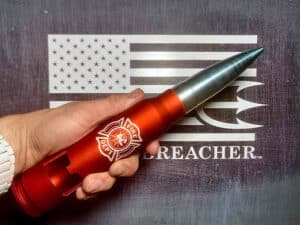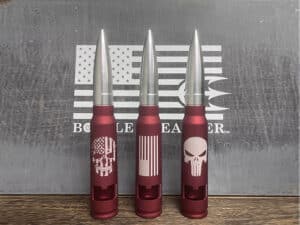Made In The U.S.A. Products From
Bottle Breacher
Small Businesses like Bottle Breacher have a positive impact on Triple Bottom Line: People, Planet and Profit. Making products in the U.S. and employing U.S. veterans helps reinforce our commitment to American values, quality products, and economic strength. The GREENandSAVE team applauds the efforts of entrepreneurs that help keep jobs in America. They especially appreciate business leaders like Eli Crane of Bottle Breacher, that employ U.S. military veterans, who sacrificed so much to support the freedom that we too often take for granted.
Bottle Breacher uses multiple different caliber ammunition casings that are completely safe. Each opener is professionally powder coated, not spray painted. The process takes time but keeps the finish for years to come. Their brass is professionally polished, giving it the extra shine that distinguishes it from all others. Engraving is done with a laser engraver right in their Arizona shop, which creates a unique contrast between the engraving and the coating of each Bottle Breacher. The attention to detail leaves the openers with a clear and precise finish.
Eli was a Navy SEAL and “breaching” is the term for penetrating or opening a secured location. So, breaching a bottle makes a lot of sense for the name Bottle Breacher.
In this Presidential election year, local broadcast news reporters and top rated cable players like Bill O’Reilly and Bret Baier on FOX News should interview small business owners like Eli Crane. Viewers have heard enough from political “experts,” and entrepreneurs can share their constructive insights into policy and growth strategy to make America stronger. Fifty years ago, a third of U.S. employees worked in manufacturing, making everything from clothing and cars to brushes and…bottle openers. Now, only about one-tenth of the nation’s 130 million workers are employed by manufacturing firms.
Why does U.S. Manufacturing matter to our economy?
The economic ripple-effect is a multiplier and manufacturing has a higher multiplier than any other industry. According to the Bureau of Economic Analysis (BEA) annual input-output tables have calculated that a dollar’s worth of final demand for manufacturers generates $1.48 in other services and production. This is higher than any other sector. The retail and wholesale trade sectors have much lower multipliers, generating 54 cents and 58 cents respectively in other additional inputs for every dollar of economic activity they generate. It turns out that those figures underestimate the actual impact that manufacturers have. A new analysis by Inforum, an economic consulting service working out of the University of Maryland, suggests the manufacturing multiplier is much higher – $1.92, almost doubling the base value of the manufacturing output itself. (Source:industryweek)
Why does U.S. Manufacturing matter to our environment?
#1: China is an ocean away with about 7,000 miles of distance to transport goods.
#2: The Guardian has reported confidential data from maritime industry insiders based on engine size and the quality of fuel typically used by ships and cars shows that just 15 of the world’s biggest ships may now emit as much pollution as all the world’s 760 million cars. Low-grade ship bunker fuel (or fuel oil) has up to 2,000 times the sulphur content of diesel fuel used in US and European automobiles. The recent boom in the global trade of manufactured goods has also resulted in a new breed of super-sized container ship which consume fuel not by the gallons, but by tons per hour, and shipping now accounts for 90% of global trade by volume. (Source: gizmag and theguardian)
#3: The environmental impact of shipping includes greenhouse gas emissions, acoustic, and oil pollution. The International Maritime Organization (IMO) estimates that carbon dioxide emissions from shipping were equal to 2.2% of the global human-made emissions in 2012 and expects them to rise by as much as 2 to 3 times by 2050 if no action is taken. (Source: en.wikipedia.org)
Read the full story from the GREENandSAVE staff.




